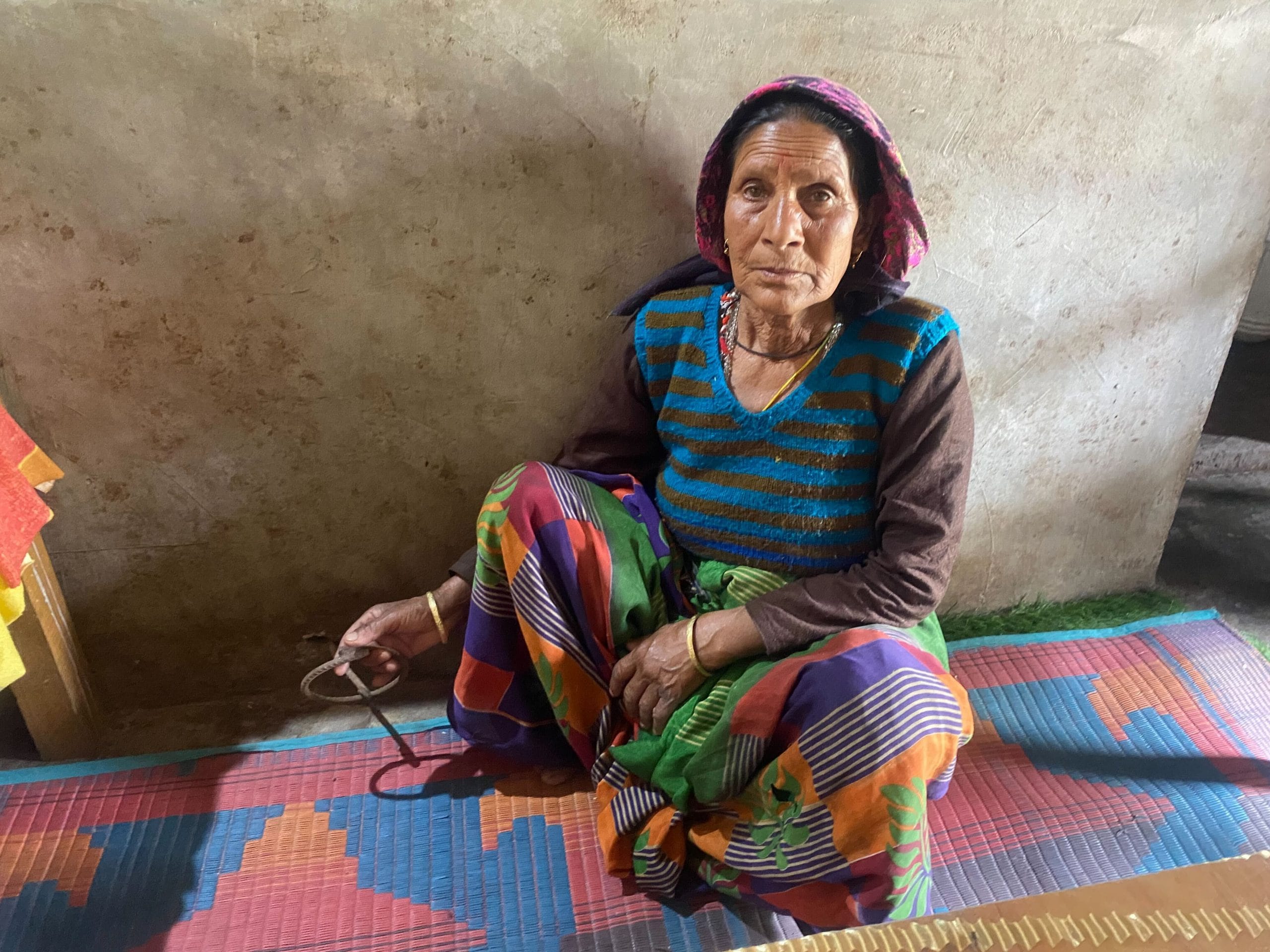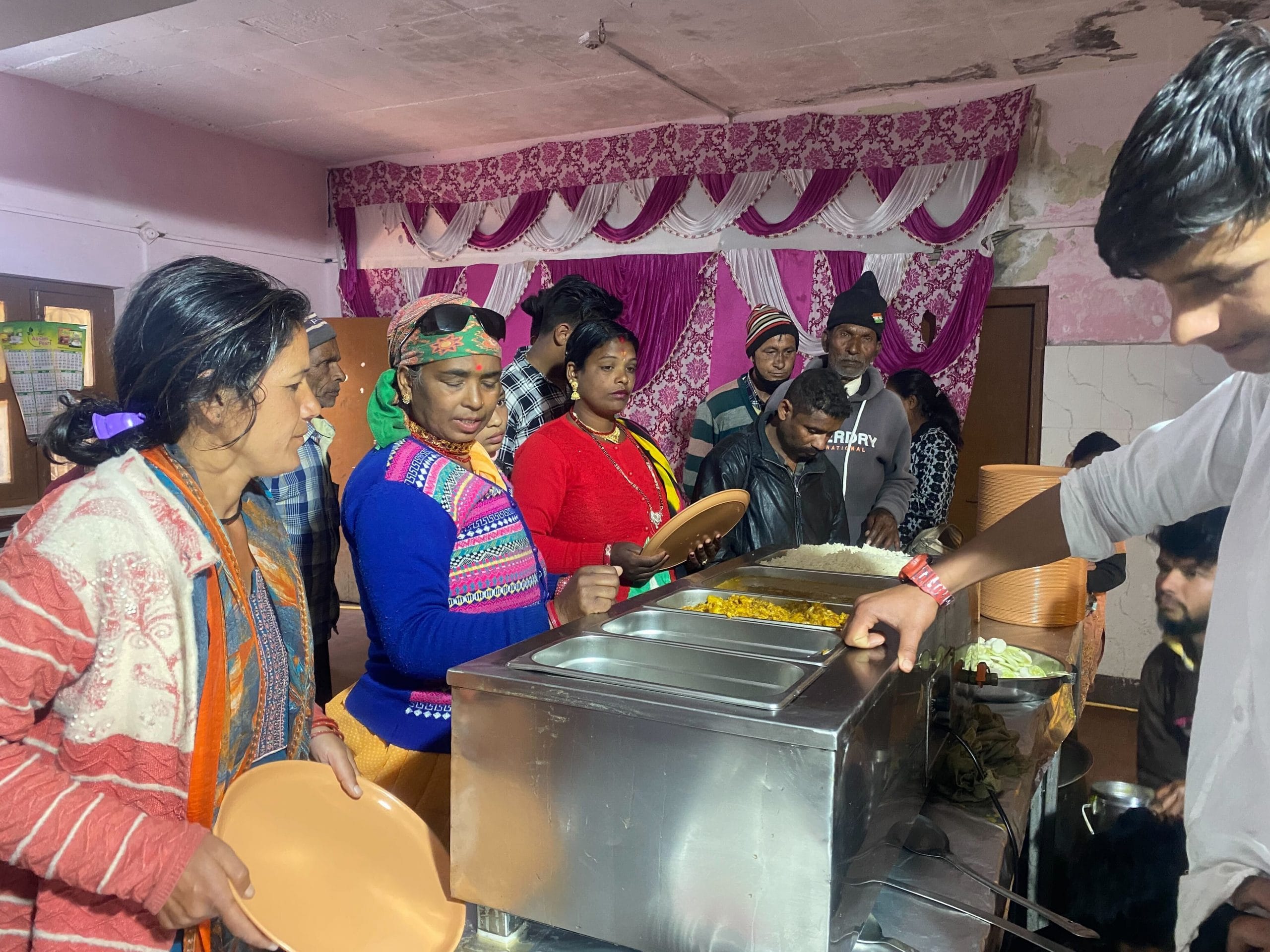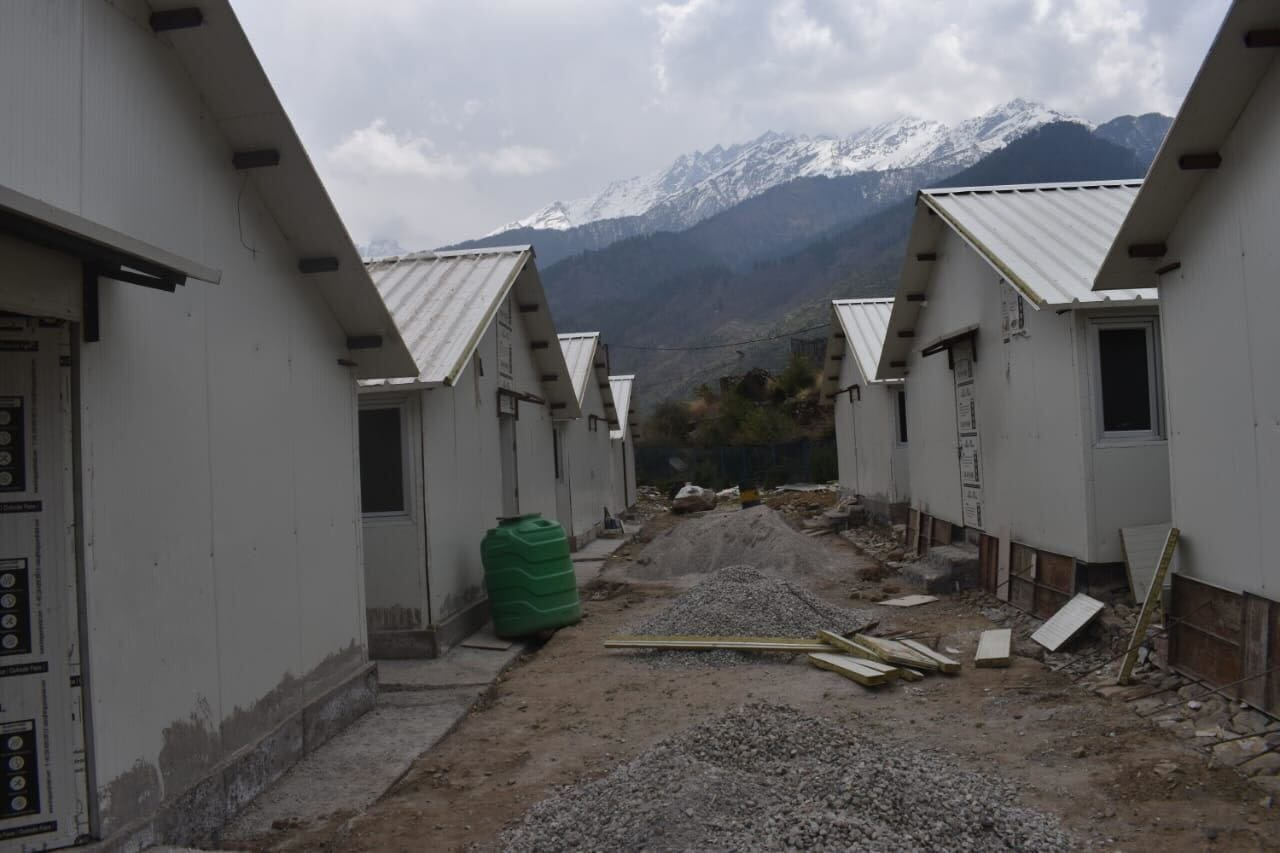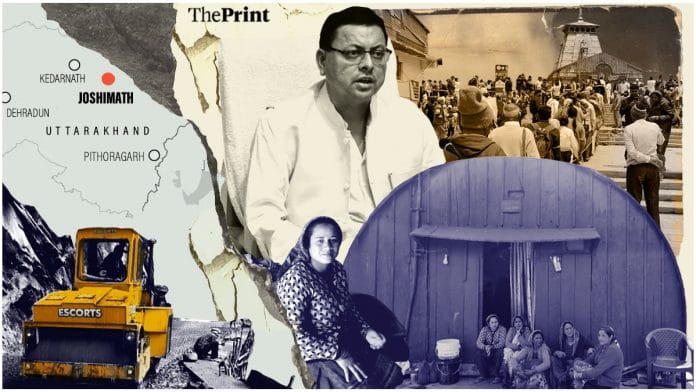Joshimath: Bharti Devi, 65, has been living in a tin-roof makeshift Joshimath shelter where horses once lived, and cooking food in troughs since her mountain home developed dangerous cracks in January. Several hundred like her are trapped in dreary shelters fighting for compensation after being displaced by Himalayan land subsidence. Their homes are just too unsafe to return to.
But new anxieties are rising among the displaced people after Uttarakhand Chief Minister Pushkar Singh Dhami declared Joshimath safe for Char Dham Yatra.
Not too far away from the stable-turned-shelter, the local market is festive and buzzing with activity in anticipation of the Char Dham Yatra annual pilgrimage and the over 50 lakh tourists who will descend on the Himalayan town, a pit stop for pilgrims. Carpenters are making new beds, hotels being repaired and shops stocked anew.
Joshimath residents are divided.
It has just been three months since the land subsidence shook this town and over 800 homes developed cracks. The last crack was reported on 5 February. Now, the yatra is set to begin on 22 April and Badrinath temple will open on 27 April. The number of pilgrims will break previous records, Dhami said.
“Everything is now safe in the town and there is no fear in the minds of people,” he said. “The state government has taken positive steps to overcome the problem.”
But for some, the joy of the pilgrimage season is muted this time. People who fled their cracked homes in panic have been drowning in paperwork since January, fighting for monthly subsistence, living out of shelters, and negotiating compensation and alternative homes with officials.
“If Joshimath is safe, then the Chief Minister should see our ruined houses and sunken land and then say that Joshimath is safe,” 59-year-old Rishi Devi said, pointing to the collapsing houses, her eyes moist. “We will block the roads and not allow this yatra to happen until the Chief Minister listens to us and gives written assurance.”
Her sons are staying in hotel rooms paid for by the government. Earlier, the date for evacuating hundreds of people from the hotels was 31 March. It was extended to 30 April. Now, there are concerns about how long people will be allowed to stay in hotels as pilgrims will throng Joshimath.
“First we were kept in a government school, when the school opened, we were put in the animal shelter. The government is not able to see that we are humans and not animals. Our life is shattered,” said Rishi Devi.
Also Read: Why towns and villages in Uttarakhand are sinking — unplanned townships, tourist & pilgrim infra
Is Joshimath safe?
Joshimath is still reverberating with the scale of displacement: 868 structures developed visible cracks of which 181 are in the unsafe zone, 409 people (144 families) are living on rent or with relatives, and 586 people in hotels, guest houses and shelters provided by the government. The numbers are updated every day.
The wheels of compensation and rehabilitation are grinding slowly, but for now, the Char Dham Yatra is the priority. Teams are widening roads, repairing cracked and broken sections, and building walls along the corners of mountain roads as a safeguard against landslides. Work is going on at a frenetic pace to meet the 22 April ‘deadline’ — when the pilgrims are expected to descend on the small town.
Kumkum Joshi, SDM of Joshimath, is at the helm of these preparations.
“Road construction work is going on. Lakhs of people will pass through here and the administration is making every possible effort to make the journey smooth,” said Joshi.
Heavy machinery and a large number of labourers have been engaged in order to widen the roads. The state government had tasked the National Geophysical Research Institute (NGRI) to study the roads leading to Badrinath and repair sections that were found to be sensitive.
There was no question of the yatra being cancelled. According to CM Dhami, preparation for this year’s yatra began last year itself.
“Till now, I have chaired four meetings on Char Dham preparations. Be it safety or deployment of doctors, we are taking care of all issues. We will ensure pilgrims return with an even better experience this season and they do not face any problem,” Dhami said earlier this month.
But roads are not the only thing the government should worry about. Experts warn that the drainage system is equally important.
“Lakhs of people will come to a place where 20,000 live. So pressure will definitely increase,” says geologist Naveen Juyal.
The 1976 Mishra Committee report on why Joshimath was sinking noted that the town lies on an ancient landslide, resting on a deposit of sand and stone, not rock. It not only warned against the removal and blasting of boulders along the hillside but stated that water seeping from the soil should be removed through drainage channels to avoid landslides.
Every day, thousands of litres of water is being drained. But now imagine what will happen when lakhs of people come here, Juyal explained. “Water drainage will increase and landslides can arise,” he warned.
Residents have mixed feelings about the yatra. The pilgrims bring with them the promise of business and trade. But people are unhappy with the CM declaring that Joshimath is safe.
“The Char Dham Yatra is a very important source of income. But we have warned the CM that we will hold a chakka jam (block the roads) whenever the pilgrims come. We haven’t made any decision till now,” says Atul Sati, convenor of Joshimath Bachao Sangharsh Samiti, which he founded in 2004.
Also Read: Why Joshimath should have moved ground beneath India’s planners decades ago
Demands and protests
Every day, for 105 days, there has been a protest outside the SDM’s office near the bustling Joshimath market. Sometimes, it’s a handful of 50 people. On other days, over a hundred gather and when important announcements are made the numbers swell to 300-400. Most of the protesters are women. They raise slogans, share their problems and offer advice to each other.
Hundreds of affected families have rallied under the banner of the Joshimath Bachao Sangharsh Samiti. Their 11 demands include speed up rehabilitation efforts, give land in exchange for land and houses in exchange for houses, provide employment, and compensate losses. These are their immediate concerns, but they also want the NTPC to stop work on the Tapovan Vishnugad hydropower plant project and the government to scrap the Helang bypass, and part of the Char Dham road widening project. The committee also wants Joshimath to be declared disaster affected.
“For the last four months, work on the NTPC project and the bypass has stopped, but it is not permanent,” said Sati.
A few days ago, representatives of the citizen’s collective met with Dhami and presented him with their demands. They claim the CM assured them that he would look into their demands and urged them to end their protest. But the Samiti is not satisfied. They want written assurances from the government.
“We want minutes of the meeting held with the CM so that we have something concrete on the assurances given to us,” said Sati.
Their priority is to rehabilitate everyone without houses.
Also Read: ‘Catastrophe insurance’ becomes more urgent after Joshimath. Fiscal transfers can’t rebuild lives
Unsafe zone
Kiran Kumari’s house is in the unsafe zone. She was all set to begin her housewarming ceremony in January when the temple town started caving into itself.
Cracks appeared on the walls of Kumari’s new house on 2 January, and she fled with her four-month-old baby and husband.
The family moved into one of the seven shelters in Sindhar, which formerly housed the Army’s mules. Outside, the sun shines brightly, but it cannot dispel either the gloom or the pungent cattle smell within. The lone small bulb in the shelter that was home to 30-40 mules is inadequate for the seven people crammed inside.

“My new house was painted white. I had chosen yellow and pink for the bedroom. We were going to buy a new bed. But now, we don’t know where we will go,” said Kiran.
She uses an almirah and a fridge to partition her section of the dwelling. Food items and bedding are arranged neatly in the troughs where the mules were fed. She and the others in the dwelling have to share the lone bathroom outside. The lack of clean and safe hygiene facilities is a health hazard for the elderly and her children. The residents also claim that no doctor has come in to check on them.
“I am afraid to go to the washroom at night, lest a snake or a bear comes. Children also stay inside at night,” said her mother-in-law Bharati Kumari, who lives in the same shelter.
Some families have returned to their dilapidated homes despite the risk.
“We had left our house and gone to the hotel in February but have now come back,” says Shashi Kumari, standing under the cracked roof of her home. She was put up in a hotel but had to walk to the municipal mess hall for breakfast and lunch. She’s worried that she will be evicted.
“If I am removed from my house too, I will take a tarpaulin and tie it on the road and stay there with my family,” said another Joshimath resident sipping on a cup of tea in the waiting area of the tehsil’s office. He along with 10 others had planned to stage a protest on 15 April, but then it started to rain.
So far, the government has disbursed Rs 11.35 crore to 46 of the 868 affected families, said Kumkum Joshi, SDM of Joshimath. Kumari and Bharati’s families received Rs 1 lakh each.
“Whoever is applying for the compensation is getting it. As of now, more than 45 people got compensation. We are doing everything we can to make this process easy for the people,” said Kumkum Joshi.
But residents want their homes back.
“They are giving money, but for that one has to show all the documents. They are asking for so many things. We need a house. What are we going to do with this money if there is no home to live in,” said Munni Devi, who is living in a guest house.
Rehabilitation not a priority
In the last three to four months, the administration has been engaged in attending to the needs of people housed in shelters and relief camps.
Each day around 1 pm around 180-200 people living in hotels and guest houses gather in the municipality hall to eat lunch provided by the government. It’s usually a mixed vegetable, daal, rice and poori with either gulab jamun or rasgulla for dessert. Breakfast and dinner are also provided.

A clerk diligently takes down every person’s name, and where they’re staying in a thick register.
“I come here once a day to eat. Good food is available—breakfast, lunch and dinner. But I come only once because it takes me time to come all the way from my house,” says Chandraram who has moved back into his “broken” house in Mohanbagh. The residents have to walk for a distance of around 2 km to reach the hall.
Women come with their children. They sit on the chairs and eat as people do during important functions and wedding parties.
The government spends Rs 435 per person for a day’s food and around Rs 950 a day for lodging. It’s an expensive undertaking.
“The food is good. I have been eating here for three months. I am happy with the government’s work, but how long will I stay in the hotel?” says Munni Devi, who is temporarily staying at the Bharat Guest House in Joshimath.
Himanshu Khurana, district magistrate of Chamoli district said that the government is building temporary houses for people who lost their homes.
“Based on the study done by the scientific institutions, experts will tell us which areas are safe and which are unsafe. On the basis of that, it will be known where we can do reconstruction and redevelopment in Joshimath,” he said.
The administration has constructed 15 temporary houses 14 km away from Joshimath in Dhaka village. It has barely made a dent in the rehabilitation effort. The temporary white structures have two rooms, a kitchen and a bathroom.

But families don’t want to move there. It’s not their village.
“We will not go there. It is very far and our children go to school here. There is no point in going there for us” said Munni Devi, as she left the municipality hall with a packed lunch for her husband who is sick.
The food is good, but it does not dull the gnawing uncertainty of the immediate future. Will she be asked to leave the guesthouse when the pilgrims arrive? Nobody knows, but rumours are rife.
Hotel owners and people running homestays that have been declared safe are excited about the business the pilgrims will bring. Bookings are already being made.
“This time there was less snow in Auli and after the disaster in Joshimath in January, business stopped. Now we are ready for Char Dham Yatra,” said Rohit Nautiyal.
Nine rooms have been booked for 25 April, and he’s bought new beds to welcome his guests.
(Edited by Theres Sudeep)






